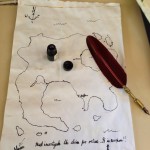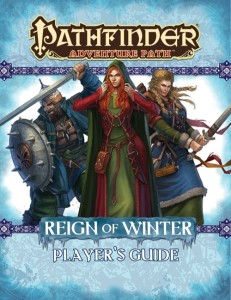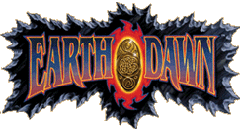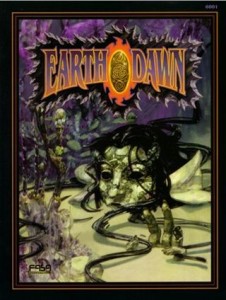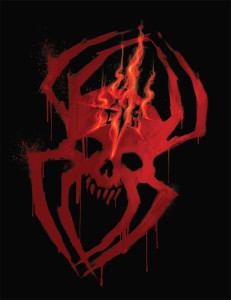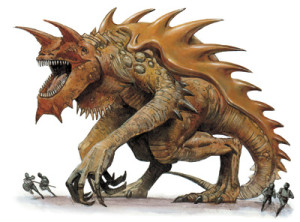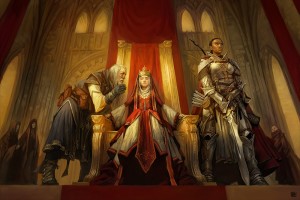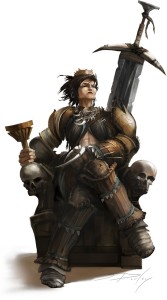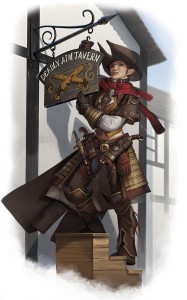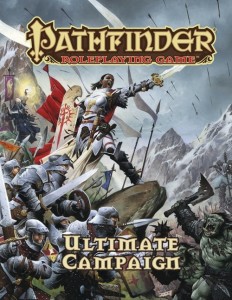 I thank you for bearing with me through the review of this book. There is just so much material packed into the 253 pages this book offers that I would have turned myself inside out trying to fit it all into one review. So we are moving on to Chapter 3 which is innocuously called Campaign Systems. So lets pull it apart in the penultimate (pun intended) review of this book.
I thank you for bearing with me through the review of this book. There is just so much material packed into the 253 pages this book offers that I would have turned myself inside out trying to fit it all into one review. So we are moving on to Chapter 3 which is innocuously called Campaign Systems. So lets pull it apart in the penultimate (pun intended) review of this book.
Campaign Systems. The title of the chapter. I wrote many posts about campaign systems on my own blog and this one so I thought I had finally reached what I truly hoped this book contained. How to build a campaign! Excellent, the secrets of Paizo laid bare so I too can create my masterpiece adventure path. I was devastated to find I was completely wrong. This chapter had no insight on how to build your campaign from the ground up.
Of course that is because they have done it all before. In the core book and the Game Master Guide there is plenty of advice they give on these very topics. Perhaps not to the depth everyone likes but that is where I can fill in the gaps by writing blogs about different styles. In the chapter they cover numerous systems (meaning extra rules) to cover various concepts in game and how to manage them as a player and a GM.
There is good, bad, and ugly in this chapter. I was smiling with glee at stuff that surprised me. I wore a frown of confusion where I came across material that I think does not need rules (that is putting rules on it reduced role playing and increased complexity). Then I was left dumbfounded in several sections of the chapter wondering why on Golarion they had even bothered. I think a few of these systems really do depend on the style of game you play, although some of them would be much better suited to other games for sure.
The chapter starts with a fresh take on alignment. Well fresh may be a little generous, but it gives an alternative system that allows for shades of alignment. So you could be Lawful Neutral but closer to the Neutral end of Lawful and the Good side of Neutral. This introduces a mechanic which allows your alignment to shift with actions and time. Sometimes with repercussions, other times without. I rarely point to alignment in game (though I do where class powers depend on it) so this system is very unlikely to be used in my campaign. It is, on the other hand, a good basis for a system of alignment that may help people new to the game to understand it. They do try to redefine the alignments in a clearer manner also in this section but I do not think they are any clearer than the entries in the Core Rulebook.
Then they broke out bargaining which literally gave me a headache. Do not get me wrong, I love mercantile campaigns (I run one in Traveller) but Pathfinder? Really? The algorithms (solutions to the problem) are unrealistic, simplified and frustrating. It is very hard to follow the flow and I can see this coming to very little use. I really did wonder why they had included this section when the rules that exist with bluff, diplomacy, sense motive and the like all function quite well in this regard anyway.
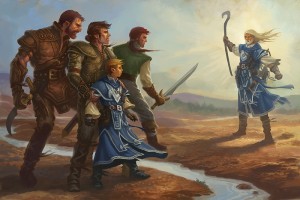 Then the next section about companions surprised me. Surprised me in a major way so much that I broke one of my personal rules and wrote on my own blog about this section prior to writing about it here. You can read that blog here if you want, but the following pretty much covers it. The GM should control some of the player linked companions! I have always played games where if you had a familiar, animal companion, cohort, followers then you dealt with them as the player. This system really turned that on its head for me. They suggest that animal companions, followers, and to some degree cohorts should all be controlled at some level by the GM. Reading through this section it made sense why and I was grinning from ear to ear that something had surprised me.
Then the next section about companions surprised me. Surprised me in a major way so much that I broke one of my personal rules and wrote on my own blog about this section prior to writing about it here. You can read that blog here if you want, but the following pretty much covers it. The GM should control some of the player linked companions! I have always played games where if you had a familiar, animal companion, cohort, followers then you dealt with them as the player. This system really turned that on its head for me. They suggest that animal companions, followers, and to some degree cohorts should all be controlled at some level by the GM. Reading through this section it made sense why and I was grinning from ear to ear that something had surprised me.
The section also went over followers (obtained through the Leadership feat) and what they meant in game which is something I never really fathomed. It was a brief description but it gave me a point of reference as I realised that a follower was kind of like a contact that had interest in you. There was some discussion on my blog that this should really be a role playing consequence but I see this as OK. if you get Leadership and you want to have an NPC that has been following your career in a town then why not. I do agree though that this style of contact should be limited to the Leadership feat.
Which lead me to the first real ugly section of the book. The next section was Contacts. I did not read this until after my blog discussions were over and I really wish I had. This section just completely devalues the Leadership feat that they had been describing by introducing a system for contacts. Come on! That is what the role playing is for if you do not want to take the Leadership feat. Why should there be a system that allows for a similar structure than what was just described. And if you aren’t going to describe how to make a campaign from scratch in the “Ultimate Campaign” guide because you have done that before why go over relationships with NPC’s when it is done in at least three books I can think of. This section seems counterintuitive, introduces a lot of bookkeeping to the GM and I just do not understand why it was even included.
You are probably beginning to realise there is a lot of “campaign systems” in this chapter and there are, fifteen to be exact. There are a couple more I want to talk to but I will sum the others that I am not going into too much detail with here. The Exploration, Honor, Lineage, Relationships, Retirement and Young Characters sections were entertaining and I may take some concepts from them into game. The Taxation and Investment sections should never have been included. Tax the characters? We are considering tax and percentage return in a fantasy system… No thank you. So that leaves me three sections to talk about. So I end on a positive note I am going to go from worst to best…
Retraining. There is a chapter here about how your character can retrain any change they have made in their character as long as you have time and gold. This is the most ludicrous waste of space of a system I have ever read. Six levels in and you realise you did not like becoming a necromancer? that is OK, take a holiday and become an evoker instead! Taken a Wisdom upgrade and realised Dex would have been a better choice, no problem! This is just a nightmare. In reality this is normally dealt with with a discussion between the player and the GM. Player: Look, I was a bit rushed last time I levelled and I think I should have taken x feat, can I change it? GM: Sure, you haven’t used the one you took in any major way, no problem. This entire idea of retraining devalues things like spell replacement in Sorceror (and other classes) and is like saying to a player not to worry about considering what you want to play because you can always change it later with a nominal sum of gold and a bit of in game time. If you can’t tell, this section really annoyed me.
Reputation and Fame. If all you have are the core books then this is likely to have some value for you. I collect Adventure Paths (AP) and also some campaign supplements (especially if they are mentioned in the AP as useful) and so this is about the fourth system I have come across that deals with this concept. And it is also the worst system of the ones that I have looked at. Why do they not just migrate the simplest system they have created and use it? To me it would be something similar to the system contained in the Faction Guide which was simple, transferrable and easy to understand. Seriously Paizo, look at what you have and stop reinventing the wheel time and time again.
Magic Item Creation. I loved the second half of this. The first half talks about how to stop min maxing players from exploiting loopholes in the system that exists and how you really should not alter a lot about the way things work (like rechargeable wands or making an intelligence modifying pair of boots). It made average reading and as I am playing a character that I am considering to use as a creator of magic items it was timely. the absolute best thing about this section was the bit that has potential for creating role playing opportunities! Think to (and try not to groan) Harry Potter where he gets his wand that has a strand of unicorn hair (or something similar in it) to make the wand. That is the cool stuff that you want to get involved in but most times for an item you spend your gold, roll the dice and make your item. In the final part of this system they talk about rare agents you can use to make COOL ROLEPLAYING OPPORTUNITIES WITH!!!!!!! Dragon heartblood! Dire animal brain! Giant squid ink and many more! Oh the possibilities. I seriously disagree with the writers that the cost of such items should be taken out of treasure hordes because you get this object as well but apart from that this is the stuff that I love to see in this book.
So, after sprinkling some stardust on my swords to grant them a light that you can search the dark places of the world with I think I had better sum up. This is the chapter where cracks in the overall coolness of this book begin to show. In summary let us look at these sections and put them where I consider they lay.
The Good: Alignment, Companions, Exploration, Honor, Lineage, Magic Item Creation, Relationships, Retirement, Young Characters.
The Bad: Bargaining, Investment, Taxation.
The Ugly: Contacts, Retraining, Reputation and Fame
The italicized section names are the best example of each category in my opinion. This chapter still has a lot of good in it, in fact more good than bad (or bad and ugly combined!) so it is a worthwhile read. I am majorly disappointed that this section did not take a close look at actually building campaigns from scratch with a modular or building block approach. With one chapter to go (final review next week!) there is little likelihood that it is going to occur. So next week we look at Chapter 4: Kingdoms and War. Until then, Keep rolling!
Mark Knights is 39 year old guy living in a small rural town called Elliott in Tasmania, Australia. I have been role playing since I was 11 years old playing the original versions of Dungeons and Dragons, MERP, Elric, Dragon Warriors and the like amongst other genre games. I played D&D 2nd Edition through the 90′s but I ran Earthdawn for my fantasy setting and loved it as a GM. When 3rd Edition came out for D&D I tried it but found it too heavy on rules. I ignored the 3.5 edition of DnD in favour of Earthdawn (big mistake) as I thought it was just a money spinner. When 4th Edition DnD came on my players and I gave it a red hot go but hated what it had dumbed the game down to be. On a trip to Melbourne to buy some 4E stuff from a hobby store an old mate of mine pointed me at Pathfinder and in a Fantasy setting I have never looked back.





